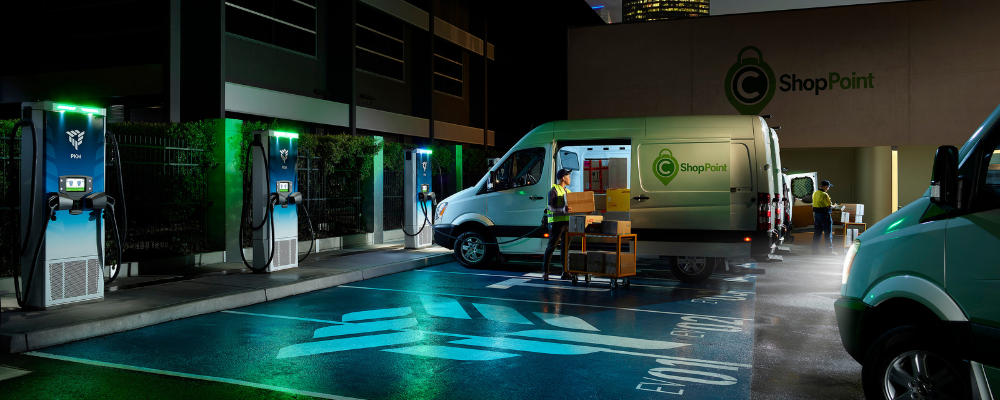What does the Inflation Reduction Act (IRA) mean for EV charging?

The Inflation Reduction Act (IRA) is a law that provides nearly $370 billion in climate change investments to help reduce carbon emissions by 40 percent by 2030. It provides significant tax breaks for businesses that purchase new medium and heavy-duty electric vehicles (EVs) and new chargers.
These include:
- A Clean Commercial Vehicle Credit for 30% of the difference between the cost of the clean vehicle and its gas-powered counterpart – up to $40,000 per medium/heavy duty commercial EV
- An Alternative Fuel Vehicle Refueling Property Credit for 30% of total costs of purchase and installation of charging equipment—up to $100,000 per charger
- A renewal of the existing $7,500 Clean Vehicle Credit for passenger and light-duty vehicles
- A Previously-Owned Clean Vehicles Credit of $4,000 or 30% of the vehicle sale price (whichever is lower) for used EVs
The IRA tax credits will start after December 31, 2022, and end after December 31, 2032. Businesses can use the credits after receiving other grants or rebates like NEVI funding. These credits, along with many other grants and programs, make electrifying your fleet in the US more affordable than ever.
How does the Clean Commercial Vehicle Credit work?
The Clean Commercial Vehicle Credit lets businesses claim up to 30 percent of the difference between the cost of a clean vehicle and its gas-powered counterpart (up to $40,000) for a medium or heavy-duty commercial EV that weighs more than 14,000 pounds. If a vehicle weighs less than 14,000 pounds, business can claim up to $7,500 per vehicle. There are no income limits on eligibility for the tax credit and the vehicles businesses purchase don’t have to be made or assembled in North America. Businesses cannot sell the tax credits to anyone or any company (like a dealer) for cash.
How does the Alternative Fuel Vehicle Refueling Property Credit work?
The Alternative Fuel Vehicle Refueling Property Credit is a general business tax credit for any company that installs EV chargers, including direct current (DC) fast charging stations. It will offset up to 30 percent of the total costs of purchase and installation of charging equipment, up to $100,000 per charger. Businesses cannot use the credit to offset expenses related to permitting and inspection.
Companies can only use the Alternative Fuel Vehicle Refueling Property Credit for chargers installed in a census area where the poverty rate is at least 20 percent or where the median family income in the area is equal to or less than 80 percent of the statewide median family income.
Businesses can apply the tax credit after receiving other EV grants or rebates, but only to the charger costs not covered by those grants or rebates. Resellers may claim this credit even if they’re selling charging equipment to a tax-exempt organization (nonprofit), government organization, or foreign entity (state or local government/tribes), but they must disclose in writing the amount of the credit. Tritium chargers, including the RT50, RTM75, PKM150, and RT175-S, qualify for the Alternative Refueling Credit.
How does the revised $7,500 Clean Vehicle Credit work?
This is a 10-year extension of the well-known $7,500 Clean Vehicle Credit, but it has been revised. Now it is split into two parts:
- $3,750 if the vehicle is made with a battery manufactured or assembled in North America
- $3,750 if the battery is constructed with critical minerals extracted in the US or a US free-trade agreement country or recycled in North America
There is an income limit for the new Clean Vehicle Credit of $150,000 per year for an individual and $300,000 per year for a household, and the credit will be applied at dealerships during purchase. There are also limits on vehicle price: SUVs, pickups, and vans are limited to $80,000 and all other vehicles are limited to $55,000.
Last, but not least, the law will eliminate the cap on the number of vehicles that can be sold per automaker. The limit was 200,000 EVs per manufacturer, which made Tesla, General Motors, and Toyota EVs ineligible to receive the tax credit. Now you’ll be able to apply the Clean Vehicle Credit to EVs from those automakers.
How does the Previously-Owned Clean Vehicle Credit work?
This is another new tax credit for people who purchase used EVs. It’s worth $4,000 or 30 percent of the vehicle sale price (whichever is lower), and the credit will be applied at dealerships during purchase. There is a $75,000-per-year income limit for individuals and a $150,000-per-year income limit per household. The used EVs purchased must weigh less than 14,000 pounds and have a sale price of less than $25,000. The used EV must be at least two years old when you purchase the vehicle. For example, if you purchase a used EV in 2023, it must be a 2021 or earlier model year. It can be used for fuel cell vehicles and plug-in hybrids and the vehicles are not subject to the same sourcing requirements as new EVs.
Expert Consultation
There are many more US government incentives, grants, and programs to help you transition to EVs. Contact Tritium today to learn more about how to take advantage of them.